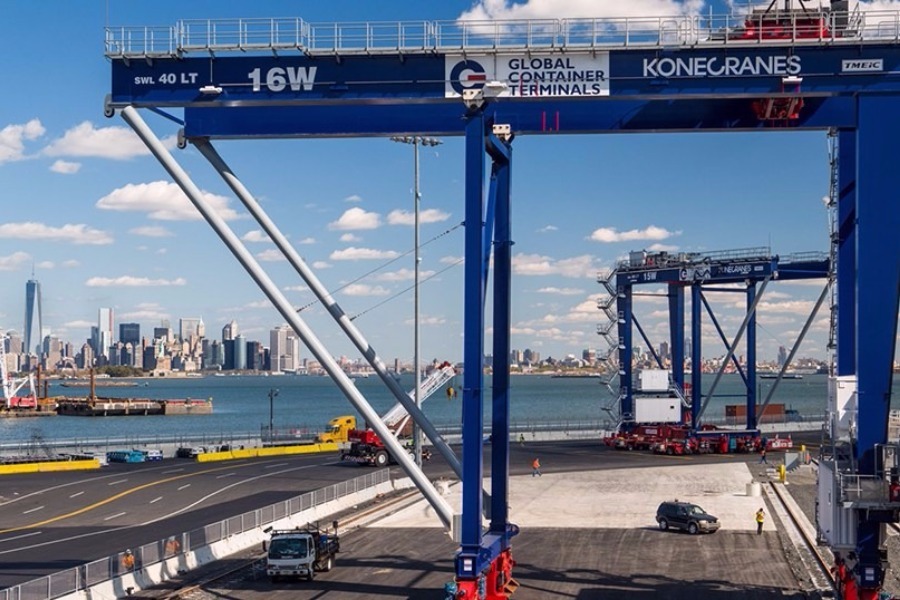Konecranes celebrates delivery of its 1 000th RTG

Konecranes has been delivering Rail Mounted Gantry (RMG) cranes to intermodal operators all over the world for many years. This year marks the delivery of the 1 000th Konecranes Rubber Tyred Gantry (RTG) crane – a milestone in its history. It was installed at the Georgia Ports Authority at the Port of Savannah in the United States.
In South Africa three 350 kg RMG’s have been installed at Transnet in Gauteng. “It is one of the largest scale installations of RMG cranes ever to be undertaken in southern Africa,” says John MacDonald, Service, Sales and Marketing Director at Konecranes Southern Africa. “Weighing over 350 tonnes, the cranes are each able to move a container every three minutes”.
Konecranes’ RTG crane is an integral part of the global company’s product offering. The RTG was developed more than 20 years ago and remains the top choice for container terminals around the globe.
Konecranes’ RTG has three main features which were part of the design from the start. The non-hydraulic design, unique to Konecranes’ RTGs in the 1990s, has since been adopted by competitors. Nonetheless, Konecranes was among the first to realise the immense benefits of non-hydraulic RTG cranes, which are designed to provide higher reliability, less downtime and lower maintenance and spare part costs, particularly at ports that experience harsh coastal weather.
Two other main features have remained part of Konecranes’ unique and market-leading RTG design. First is the Direct Gantry Drive design with 16-wheel mechanism that separated Konecranes’ RTG crane from its competitors’ eight-wheel RTG cranes. The increase in wheels from eight to 16 meant lower wheel loads, less maintenance and minimal wear to the wheels. The extra wheels also allowed the crane to move sideways, potentially increasing productivity.
The other unique patented feature of the Konecranes RTG is the Active Load Control (ALC) system, which is designed to prevent containers from swaying, and enable the fine positioning of the spreader. When combined, these features are intended to significantly speed up the container handling cycle, increasing the productivity of yard operation.
The benefits likewise extend past the ease of container handling. With decreased unnecessary movements due to the precision of the ALC system, productivity can remain kept at its highest level and energy-waste can be kept to a minimum. The use of AC-motors and frequency converters, instead of direct current technology, can also lead to significantly improved eco-efficiency.
Despite the innovative features, Konecranes’ RTG was not a straightforward success story. Konecranes’ approach to the RTG crane was unfamiliar to most container terminal operators, who were hesitant to order the slightly more expensive crane in favour of the more affordable partly hydraulic-driven RTG cranes.
However, after word spread of the RTG crane’s unique features through user references, success followed. Konecranes’ RTG has come a long way since the first prototype was built in the city of Hyvinkää, Finland, over 20 years ago. The original idea has paved the way for new applications and features, which in turn have enabled new markets to emerge.
The first Konecranes’ RTGs were used solely by seaport terminals. The 1 000th RTG was installed at the Georgia Ports Authority at the Port of Savannah in the United States. With 22 ship-to-shore cranes (soon to be 26) and 146 RTGs, the Savannah Terminal is furnished with more pieces of Konecranes equipment than any other container terminal in the world. It is the fourth-busiest container terminal in the United States.
The latest chapter in the RTG’s story is the BOXHUNTER RTG crane. The BOXHUNTER is operated at ground level and integrates several innovative technologies that aim to improve the user’s experience and bring savings for the terminal. The new addition to Konecranes’ RTG portfolio targets previously unconquered market areas, mainly developing countries.


